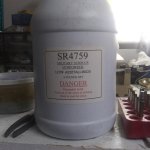max503
Member
Some years ago I bought this jug of military surplus SR4759. Apparently it came from disassembled ammo. I knew that when I bought it, and I got it at a very good price.
If you were to look closely you could see small flakes of brass in the powder, as well as what look like flecks of a black sealant. There's not much in there, but you can see it if you look.
What I've been doing is pouring the powder onto a slanted piece of cardboard. With a little tapping the powder kernels roll down the cardboard and the brass and sealant specs get left behind.
My "processed" powder works just as well as normal SR4759.
I'm wondering if I need to go through this extra step. If I didn't I could see a very few brass flakes and some specs of the sealant getting left in the bores of my guns.
Do you think this could be a problem?
Personally I don't think the flakes would cause a problem, but I process it anyway just to be sure.
Anyone ever run into a situation like this?
If you were to look closely you could see small flakes of brass in the powder, as well as what look like flecks of a black sealant. There's not much in there, but you can see it if you look.
What I've been doing is pouring the powder onto a slanted piece of cardboard. With a little tapping the powder kernels roll down the cardboard and the brass and sealant specs get left behind.
My "processed" powder works just as well as normal SR4759.
I'm wondering if I need to go through this extra step. If I didn't I could see a very few brass flakes and some specs of the sealant getting left in the bores of my guns.
Do you think this could be a problem?
Personally I don't think the flakes would cause a problem, but I process it anyway just to be sure.
Anyone ever run into a situation like this?

